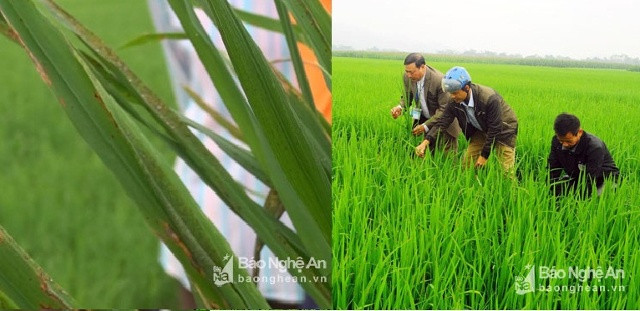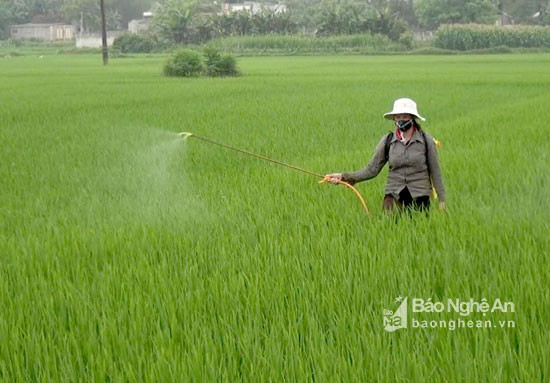Rice blast disease threatens to reduce rice yield
(Baonghean.vn) - Currently, spring rice is forming ears, however many areas are threatened by rice blast disease, which may reduce yields. Localities are actively implementing disease prevention and crop protection.
 |
| Authorities at all levels and sectors in Thanh Chuong actively inspect diseased rice fields to promptly advise farmers on prevention solutions. Photo by Huu Thinh |
According to statistics of Thanh Chuong District People's Committee,Up to now, 473 hectares of rice in the area have been infected with rice blast disease, of which 20 hectares have a severe infection rate, which risks affecting productivity and output if not prevented promptly.
The rice varieties that are seriously infected are: Huong Uu 98, Thai Xuyen 111, Thien Uu 8. The communes that are seriously infected are Thanh Yen, Thanh Khai, Thanh Luong, Thanh Tung, Thanh Khe, Thanh Thinh... Mr. Nguyen Nhu Quan - Deputy Head of the District Plant Protection Station said: When the disease is detected, the industry has recommended that people need to spray specific preventive drugs according to the 4 correct principles. If the first spraying is caught in rain, spray again after 5-7 days. During the time the rice is infected, stop fertilizing immediately...
Currently, the rice plants are at the stage of standing panicles, the leaf blast disease is temporarily controlled but the risk of neck blast disease has also begun to be warned. Therefore, to ensure a successful spring crop, localities are strengthening propaganda work to effectively prevent the disease from spreading widely.
In Nghi Loc districtMore than 7,500 hectares of spring rice are in the final stages of tillering and panicle initiation. Field inspections have found that leaf blast disease has damaged more than 300 hectares. The rate of leaf infection is generally between 3 and 5%, with some fields having an infection rate of 30-50%.
 |
| Local farmers in Nghi Loc spray rice to prevent rice blast disease. Photo by Hong Vinh |
The disease is caused by the influence of weather and severely infects rice fields planted at high density and fertilized with a lot of nitrogen, especially Lam Son 8, Thien Uu 8, and Nep rice varieties...
Ms. Dang Thi Hai - Head of Nghi Loc District Plant Protection and Cultivation Station said: "After prevention, we directed localities in the district to focus on inspection and monitoring of infected areas 1 week after spraying. If the disease has not completely disappeared, we must continue spraying, and if the disease has completely disappeared, we must continue to care for and fertilize the second time."
» Nghe An parishioners expose the corruption of priest Nguyen Dinh Thuc
Huu Thinh - Hong Vinh
| RELATED NEWS |
|---|
